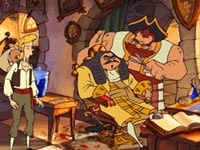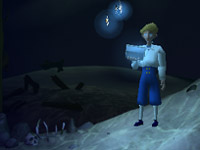Types of Graphic Adventures
Graphic adventure games fall into two categories: first person and third person. First-person games are typified by Myst, and are thus often known as Myst-alikes or Myst clones. You see the game world through the eyes of your character as you move from location to location. You often control your character using just the mouse. They often have very little in the way of an inventory: there's just not a lot of stuff for you to pick up. Instead, you tend to play with machines, turning knobs and pulling levers. There usually aren't a lot of other characters, known as non-player characters, for you to interact with. The scenes in first-person games tend to be beautiful pre-rendered art, with perhaps some areas of movement within the scene.

The Curse of Monkey Island, a 2D Game
In third-person adventures you control an on-screen avatar. You maneuver your character around the screen via mouse, keyboard, or perhaps joystick. These are the old-school adventure games typified by the King's Quest series; more recent examples include Escape from Monkey Island. Third-person games tend to be more oriented towards objects and people. There are things for you to pick up and put in your inventory, which you later can combine in interesting ways or use to solve puzzles. There are people for you to talk to, people who have information you need or are blocking your progress.

Escape from Monkey Island, a 3D game
Mixed in with all of this is the style of graphics involved. The older, more cartoony style, is known as 2D because there are only two dimensions involved. There is no "real" depth to the scene. Newer games have moved to using 3D characters generated on-the-fly and taking advantage of newer 3D graphics cards. Fans argue back and forth about whether or not 2D or 3D graphics matter. Meanwhile, publishers have more-or-less insisted that 3D is the way to go.
There is a third option: instead of using computer-generated characters, film real live people and use that. This style of computer graphics is known as full motion video, or FMV. FMV was very popular back around 1997, but there are real problems with using it in adventure games. These days very few adventure games use FMV for anything other than the occasional cut scene, a non-interactive scene which is very much like an exerpt from a movie.
What to Expect From a Graphic Adventure

The Dark Side of the Moon, an FMV game
First, realize that different graphic adventure games have different conventions. You'll have to spend some time getting used to controlling the game, learning how to move around and interact with the game world.
After that, though, expect to spend some time being stuck. It's part of the process of adventure games. After you've played a number of graphic adventure games you'll get the feel for puzzle solving, but your first experiences might be a little frustrating. If you find yourself getting extremely frustrated, take a break. Walk away from the game for a while. If all else fails, go looking for hints and walkthroughs to help you get unstuck.
And above all, have fun. It's no good playing adventure games if you just don't enjoy the experience. That said, if you find you don't like one style of graphic adventure game, try another. This is especially true of first-person versus third-person games. Some people absolutely despise third-person LucasArts-style games, while others can't bear to play another Myst-alike. If you haven't liked one, try a different one.
